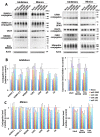Global protein conjugation by ubiquitin-like-modifiers during ischemic stress is regulated by microRNAs and confers robust tolerance to ischemia
- PMID: 23094087
- PMCID: PMC3475703
- DOI: 10.1371/journal.pone.0047787
Global protein conjugation by ubiquitin-like-modifiers during ischemic stress is regulated by microRNAs and confers robust tolerance to ischemia
Abstract
Hibernation torpor provides an excellent model of natural tolerance to ischemia. We have previously shown that massive global SUMOylation occurs during hibernation torpor in ground squirrels. We have also shown that overexpression of Ubc9, SUMO-1, or SUMO-2/3 provides protection against ischemic damage in cell lines and cortical neurons exposed to oxygen/glucose deprivation, and in mice exposed to middle cerebral artery occlusion. We have now extended our study to other Ubiquitin-Like-Modifiers (ULMs), which have multiple cellular functions during stress, in order to assess the possibility that they also have roles in tolerance to ischemia. We found that not only SUMO conjugation, but also global protein conjugation by other ULMs including NEDD8, ISG15, UFM1 and FUB1 were significantly increased in the brains of hibernating ground squirrels during torpor. By means of miRNA microarrays of ground squirrel brain samples (from active and torpor phase) we found that the miR-200 family (miR-200a,b,c/miR-141/miR-429) and the miR-182 family (miR-182/miR-183/miR-96) were among the most consistently depressed miRNAs in the brain during the torpor phase as compared to active animals. In addition, we showed that these miRNAs are involved in the expression of various ULM proteins and their global conjugation to proteins. We observed that inhibition of the miR-200 family and/or miR-182 family miRNA activities in SHSY5Y cells increases global protein conjugation by the above ULMs and makes these cells more tolerant to OGD-induced cell death. This is the first report to describe that the natural tolerance to brain ischemia in hibernators is linked to regulation by microRNAs of a broad range of ubiquitin-like modifiers.
Conflict of interest statement
Figures






References
-
- Frerichs KU, Hallenbeck JM (1998) Hibernation in ground squirrels induces state and species-specific tolerance to hypoxia and aglycemia: an in vitro study in hippocampal slices. J Cereb Blood Flow Metab 18: 168–175. - PubMed
-
- Herrmann J, Lerman LO, Lerman A (2007) Ubiquitin and ubiquitin-like proteins in protein regulation. Circ Res 100: 1276–1291. - PubMed
Publication types
MeSH terms
Substances
Grants and funding
LinkOut - more resources
Full Text Sources
Miscellaneous

